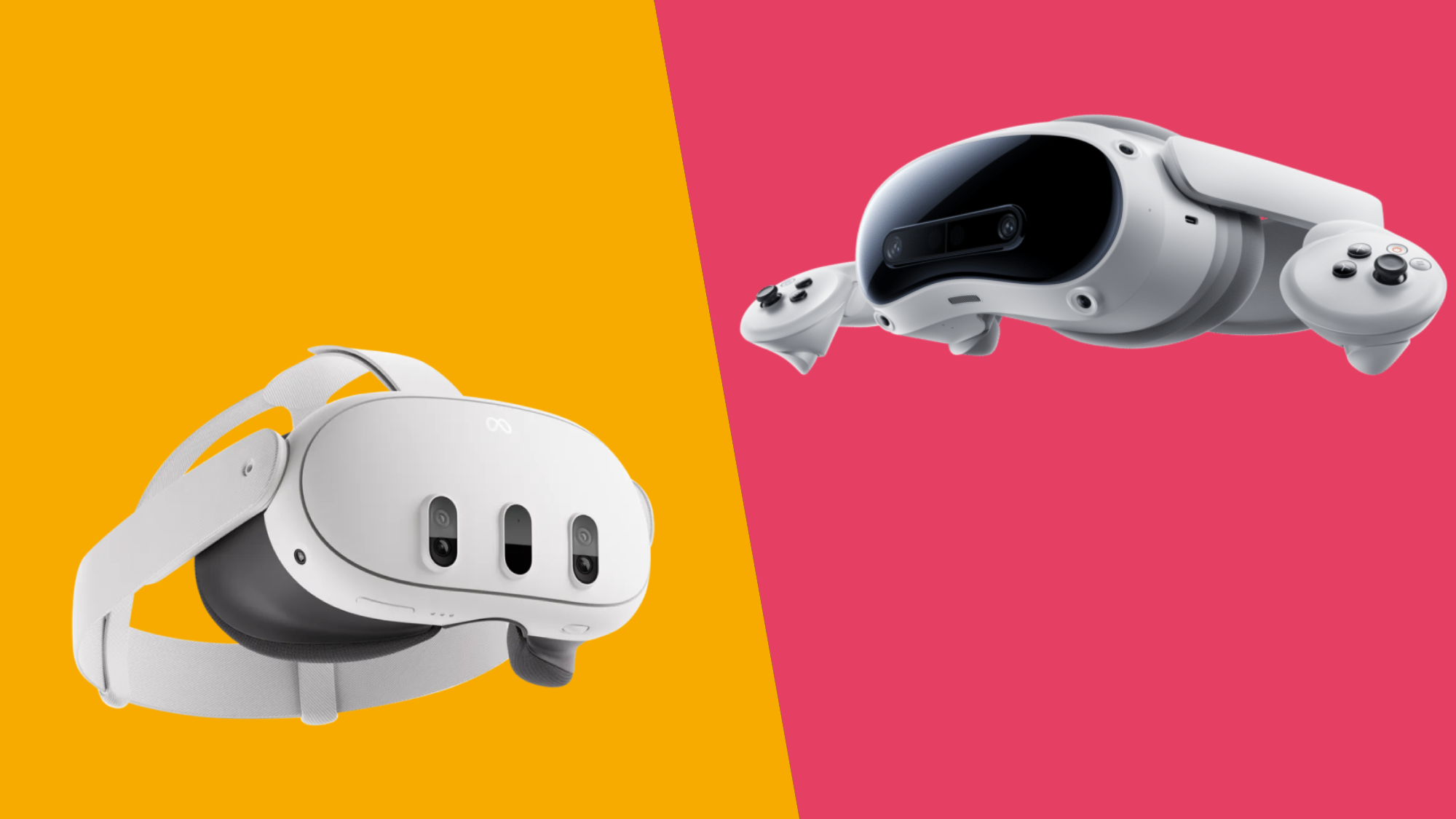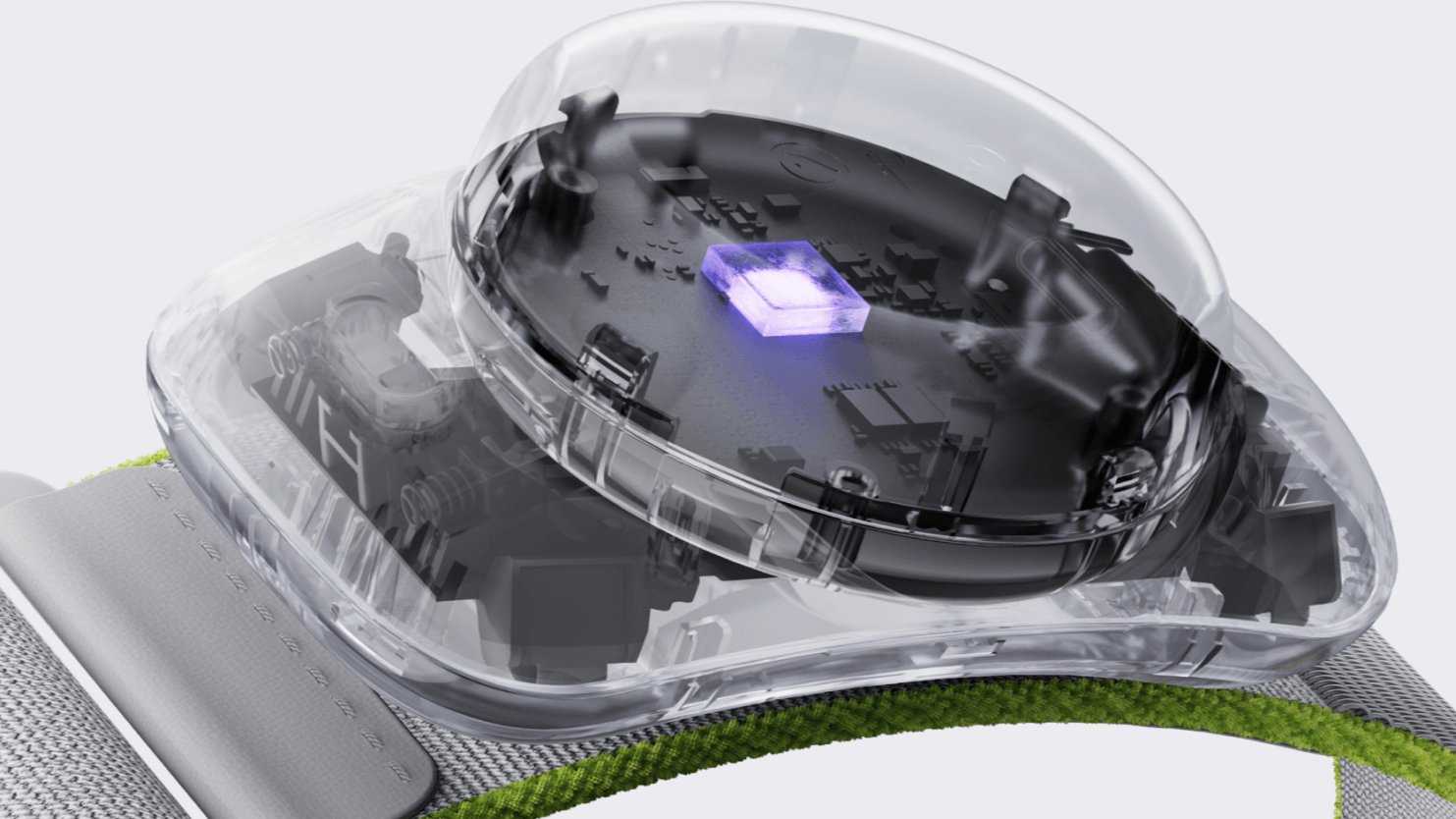
The Meta Quest 3 is currently Meta's best VR headset and it's clearest strength is its software support via Horizon OS. That's not to say the hardware is anything to sniff at mind with good full-color passthrough, and a Snapdragon XR 2 Gen 2 chipset that can handle the XR challenges you throw at it. It's also the cheaper of the two headsets.
For
- Vastly better graphics than Quest 2
- Improved mixed reality
- Incredible suite of software
Against
- Pricier than the Quest 2 at launch
- No eye-tracking
- The design is good, but not yet perfect
The Pico 4 Ultra has come out swinging with better specs (at a higher price) and some features you won't find on Quest like its Motion Tracker add-ons which are perfect for fully immersive VR gaming. Unfortunately the hardware is let down by its software to some degree, but that doesn't mean you should instantly disregard this Pico headset.
For
- Motion Tracker accessories bring foot tracking
- Great specs for the price
- Simple and intuitive
Against
- Software support lacking major exclusives
- No silicon facial interface in the box
- Beast feature is a paid add-on
The Pico 4 Ultra VR headset is finally here, and it’s ready to take on the Meta Quest 3 in the mid-range standalone VR headset space. I’ve tested both headsets extensively, and in this guide I’ll tell you if you should go with the tried and tested Quest model, or choose Pico’s potential usurper of the VR throne.
At a glance the Pico 4 Ultra offers better specs at only a marginally higher cost, but Meta’s Quest 3 is backed up by plenty of heavy-hitting VR software exclusives. It’s a close fight, but there can only be one winner – and we’ll let you know which headset comes out on top for value, performance, the mixed-reality experience, software, and features, as well as overall.
For more details on either headset we’d recommend reading our in-depth Meta Quest 3 review and Pico 4 Ultra review – though if you care about spoilers don’t look at their scores as they’ll give the result away.
Pico 4 Ultra VS Meta Quest 3: Price and Availability
- Meta Quest 3 is cheaper and more widely available
- Pico 4 Ultra has better specs to justify a higher cost
- Value verdict: Tie
The Meta Quest 3’s cheapest model costs $499.99 / £479.99 / AU$799.99, while the one and only Pico 4 Ultra model will set you back £529 (around $695 / AU$1,025). As you can see from the specs table below, that additional £50 from Pico nets you 4GB of extra RAM, 128GB of storage and, as you’ll see below, some exclusive tools like cameras for capturing spatial images and video.
So bang for your buck hardware-wise, the devices feel very even, though availability is in the Quest 3’s favor. That’s due to the Pico 4 Ultra only having launched in parts of Europe, including the UK, and Asia, while the Quest 3 is available in more regions – most importantly for our readers the US and Australia.
If you’re in those countries you could theoretically buy the Pico 4 Ultra as an import, though that’ll likely cost you extra and can be a hassle.

Pico 4 Ultra VS Meta Quest 3: Specs & Performance
- Pico 4 Ultra has equally good or better specs
- No major apps seriously justify the performance boost yet
- Specs and performance verdict: Pico 4 Ultra
Going by the above specs table, and as mentioned in the Price section, the Pico 4 Ultra edges ahead of the Meta Quest 3 if we look at the base model of the Quest 3 (the Ultra only has one option).
Pico’s new VR headset will net you 12GB of RAM versus 8GB for the Quest 3; 256GB of storage versus 128GB; and two 2,160 x 2,160 pixels per eye LCD screens versus 2,064 x 2,208 pixels per eye, though the Meta’s Quest 3’s screens can hit a refresh rate up to 120Hz rather than 90Hz.
Both headsets boast the Qualcomm Snapdragon XR2 Gen 2 chipset, which is the current-gen standard for mid-range VR headsets. Though they rely on different operating systems running on those chipsets; Meta has HorizonOS while Pico has Pico OS, and while they both are based on Android HorizonOS tends to be a cleaner and more well optimized experience.
When it comes to performance the differences seem less stark when actually using the headsets.
For me, the two things helping to keep the Quest 3 feeling on a par here are Meta’s excellent HorizonOS optimizations which allow the Meta Quest 3 to efficiently squeeze out every bit of juice from its components to maximize performance – and the fact that the Pico 4 Ultra lacks meaningful exclusives that can fully leverage its superior specs.
That’s not to say the Pico’s extra RAM and storage won’t help (especially with multitasking, which allow sup to 8 windows to be open at once compared to Quest 3's 6), but the Quest 3 equally doesn’t struggle to run any of the VR or MR experiences I’ve tried. So, until the Pico 4 Ultra launches apps that prove otherwise, there’s a part of me that feels the extra RAM is there more for its bark than its bite.
Pico 4 Ultra VS Meta Quest 3: Mixed reality

- Very close in quality
- Neither offers true to life mixed reality
- Mixed reality verdict: Pico 4 Ultra
Switching back and forth between the two headsets, and testing their passthrough performance in various settings and under different lighting conditions, I can report that there’s no standout winner here.
The Pico 4 Ultra does just push itself ahead with passthrough that’s a little more vibrant, though it does have more noticeable (yet still fairly inconsequential) distortion at the fringes of the screen. The Meta Quest 3’s passthrough is a little grainier too, though when you’re playing a mixed-reality game the differences aren’t super obvious. Neither experience comes close to looking like real life either.
Recent HorizonOS updates have delivered substantial improvements to the Quest 3’s mixed reality quality, and I suspect that if Pico brought the same levels of optimizations to its hardware the differences between the two models would be a lot more stark, with the Pico 4 Ultra more clearly in first place. It still takes the win, but I expected more from its dual 32MP sensor setup.
Pico 4 Ultra VS Meta Quest 3: Software
- Meta Quest 3 exclusives aren't matched
- Pico 4 Ultra software is better than base model was at launch
- Software verdict: Meta Quest 3
So far the headsets have been neck-and-neck, with the Pico 4 Ultra edging out the Meta Quest 3 in a few areas. When it comes to software, however, the Meta Quest 3 is clearly the best option for people who want the most complete catalog of games and apps.
The Pico 4 Ultra does boast many of the best cross-platform VR and MR titles inits collection, however, Meta has a lot of Quest-exclusives, and there are also some non-Quest-exclusive hits (as they’re on other platforms like Steam or PSVR) that aren’t currently on Pico’s platform for one reason or another.
And the Quest exclusives are mega-hits. We’re talking Beat Saber, Resident Evil 4 VR, Assassin's Creed Nexus, Asgard’s Wrath 2, Batman: Arkham Shadow, Xbox Cloud Gaming, Just Dance VR. Pico’s only noteworthy exclusive is TikTok.
I know lots of people hate exclusives, but like them or not their presence here means that if you’re looking to play the best VR games you’ll miss out on several if you go for a Pico 4 Ultra and not a Meta Quest 3.
Pico 4 Ultra VS Meta Quest 3: Features

- Pico can do everything Meta promises and more
- Motion trackers are a game changer
- Feature verdict: Pico 4 Ultra
The Pico 4 Ultra and Meta Quest 3 offer generally similar features, though Pico wins out here with two exclusive tools.
The more consequential are its Motion Trackers, which track your feet for significantly more accurate full-body tracking. They’re a lot of fun, and Meta doesn’t have its own alternative. The only downside is that, unless you pick up a pair as part of the preorder bundle (or a similar deal in the future) the Motion Trackers will cost you £79 (for two). Pico says they’re supported by “20+” standalone experiences, which isn’t nothing but is only a small subsection of its catalog.
The other unique feature is the Pico 4 Ultra’s camera for taking spatial photos and spatial videos. The image is the same quality as the passthrough (read: not great) and it’s just generally clunky to use. It’s a novelty, sure, but realistically it’s not something anyone will use regularly to capture stereoscopic content. The Pico 4 Ultra is too big, and the feature not conveniently accessible enough, to warrant carrying the headset around to capture impromptu moments in 3D.
Should you buy the Meta Quest 3 or Pico 4 Ultra?
The battle between the Meta Quest 3 and Pico 4 Ultra is close in most areas, with the two headsets either tying or the Pico 4 pulling slightly ahead in a few categories. However, the Meta Quest 3 not only wins the software category, it demolishes its rival in this respect – and this is why it’s the one to get.
Yes the Pico 4 Ultra has marginally more power and exclusive motion trackers, but it has nothing that truly takes advantage of that extra performance, and few experiences that leverage its unique features – and that power and those features come at a price premium over the Quest 3. Meta’s Quest 3, on the other hand, has a huge library of excellent exclusive VR and MR games and apps that Pico simply doesn’t have an answer for. It’s also the more widely available device.
So when weighing up which headset you’ll enjoy using more, I’m confident that for the vast majority of people it’ll be the Meta Quest 3. I’m not saying you should automatically dismiss the Pico 4 Ultra, but if you’re on the fence between the two I’d recommend that you go for Meta’s device for now.







